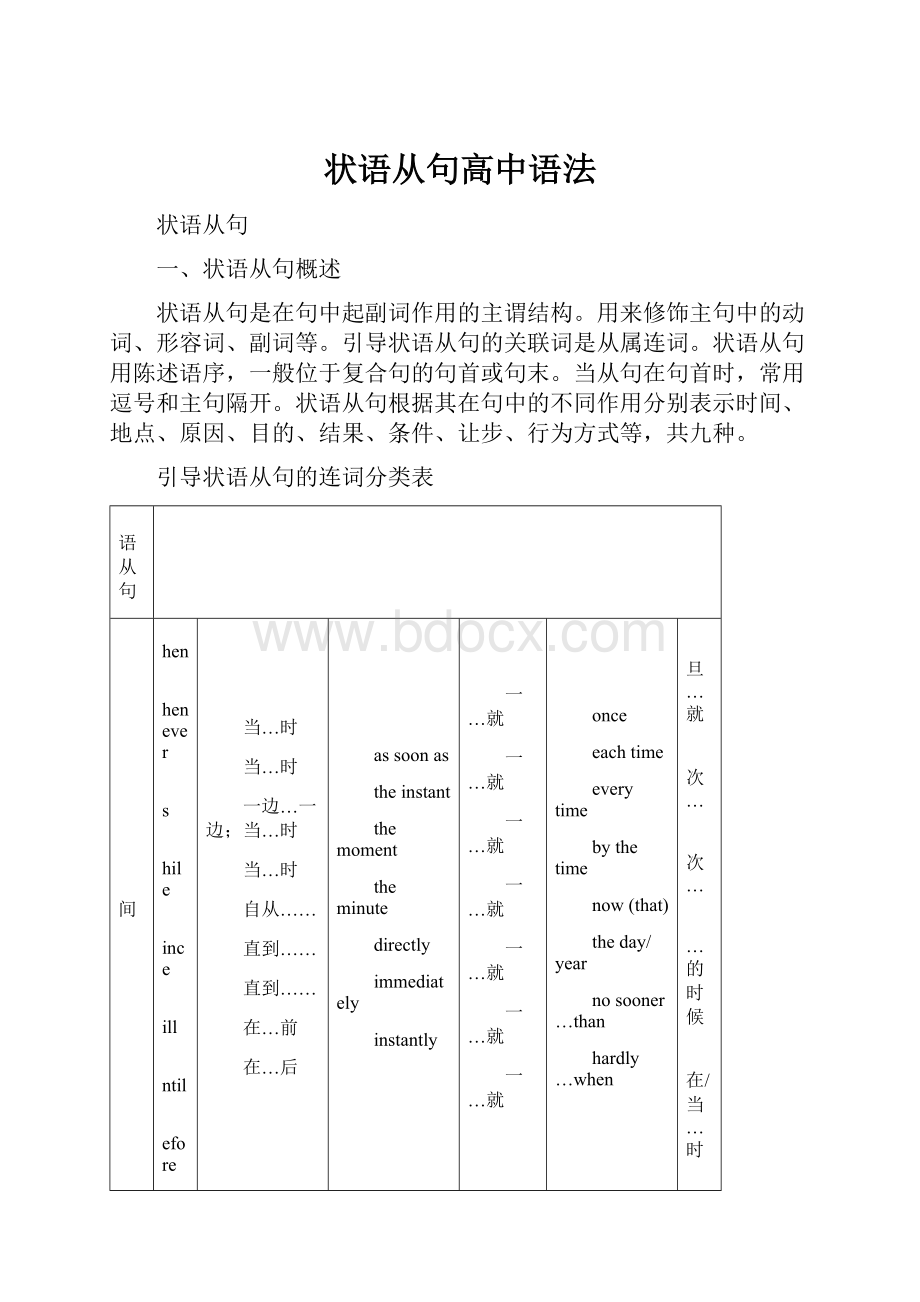状语从句高中语法.docx
《状语从句高中语法.docx》由会员分享,可在线阅读,更多相关《状语从句高中语法.docx(22页珍藏版)》请在冰豆网上搜索。

状语从句高中语法
状语从句
一、状语从句概述
状语从句是在句中起副词作用的主谓结构。
用来修饰主句中的动词、形容词、副词等。
引导状语从句的关联词是从属连词。
状语从句用陈述语序,一般位于复合句的句首或句末。
当从句在句首时,常用逗号和主句隔开。
状语从句根据其在句中的不同作用分别表示时间、地点、原因、目的、结果、条件、让步、行为方式等,共九种。
引导状语从句的连词分类表
状语从句
时间
when
whenever
as
while
since
till
until
before
after
当…时
当…时
一边…一边;当…时
当…时
自从……
直到……
直到……
在…前
在…后
assoonas
theinstant
themoment
theminute
directly
immediately
instantly
一…就
一…就
一…就
一…就
一…就
一…就
一…就
once
eachtime
everytime
bythetime
now(that)
theday/year
nosooner…than
hardly…when
一旦…就
每次…
每次…
到…的时候
现在/当…时
在…那天/年
一…就
一…就
地点
where
anywhere
在…地方
任何地方
wherever
everywhere
在…任何地方
到处
条件
if如果
onlyif只要
ifonly但愿
unless除非
as/solongas只要
incase如果
providing/providedthat假如
onconditionthat条件是
suppose/supposingthat假如
原因
because因为
as因为
seeing(that)既然
inthat因为,原因是
notthat…butthat不是因为…而是因为
since既然
now(that)既然
considering(that)考虑到,因为
onthegroundthat由于
让步
though虽然
eventhough即使
whatever无论什么
however无论怎样
granting/granted(that)即使
inspiteofthefactthat尽管
although虽然
as尽管
wherever无论哪里
nomatter无论
evenif即使
while虽然,尽管
however无论谁
forallthat尽管
whether…or无论…还是
despitethefactthat不管
比较
as…as像…一样
notas(so)as不像……一样
than比…
方式
as像/犹如…
asif/though好像,仿佛
theway…的方式/样子
目的
that为了,以便
lest以防
sothat为了,以便
forfearthat以防
inorderthat为了
Incase以防
结果
sothat结果
suchthat如此…以至于
that因而,所以
so…that如此…以至于
suchthat是这样的以致
withtheresultthat结果是,因此
二、时间状语从句
(一)when,whenever,while和as引导的时间状语从句
when表示的动作与主句的动作同时发生,或先于主句的动作。
When可指一段时间,也可指一点时间,既可以表示一时性的动作,又可表示持续的动作。
Whenever指的是任何一个不具体的时间。
while常用来引导两个同时进行的持续时间较长的动作或状态,不能表示一时性或短暂的动作。
as表示的动作与主句同时发生,具有延续的含义,一般同延续性动词连用。
while和as可译为“一边……一边”。
WhenevermymotherorIneedapermanentortrimwevisitedherdearAmaliaToland.
Asthedayprogressed,IconsideredwaystogetoutofwhateverwasgoingdownattheCullenHousetonight.
Wheneverwemetwithdifficulties,theycametohelpus.
WhenImeettherightman,Iwillgetmarried.
Asspringwarmsthegoodearth,allflowersbegintobloom.
Heenteredtheroomwhen/while/asthemeetingwasgoingon.
When/Ashefinishedthespeech,theaudienceburstintoapplause.
TomwatchedTVashehadsupper.
注意:
When和while可用作并列连词,when含义为“突然、这时”;while含义为“而,但是”。
例如:
Hehadbeenwalkingunderthetreeswhenanapplefelldown.
JanewasdressedinbrownwhileMarywasdressedinblue.
(二)nosooner…than和hardly(barely/scarcely)…when(before)句型
这几个连词词组都是表示主句和从句动作相继发生,含义为“一…就,刚刚…就”,主句动词用过去完成时,从句用一般过去时。
如果nosooner,barely,hardly,scarcely位于句首,主句需要用倒装结构,即把had放在主句前。
例如:
Nosoonerhadsheheardthenewsthanshefainted.
Hardly/scarecelyhadheopenedthedoorwhen/beforeagustofwindblewthecandleout.
Hehadbarely/hardly/scarecelydiedbefore/whenthefamilyargumentsbegan.
Hehadnosoonerdiedthanthefamilyargumentsbefore.
注意:
有的词书给出了这样的结构,barely/hardly/scarcely/nosooner…than一…就
Wehardlyarrivedthanitbegantorain.
Hardlywerethewordsuttered(说出)thanhebegantoregretthem.
(三)immediately等看似副词实为连词的时间状语从句
immediately,directly,instantly,once等可用作连词引出时间状语从句,其语义和用法与assoonas基本相同。
例如:
IgotintouchwithhimimmediatelyIreceivedhisletter.
Instantlythebuttonispressed,themineexplodes.
Thepolicemenwentintoactiondirectlytheyheardthealarm.
I’llletyouknowassoonas/onceitisarranged.
注意1)immediately,directly,instantly,once等可用作副词。
比较:
Shewenttoseehimdirectlyshegottheletter.
Shewenttoseehimdirectlyaftershegottheletter.
注意2)once引导的从句可以表示时间和条件
Onceyouunderstandthisrule,youwillhavenofurtherdifficulty.
=Assoonasyouunderstandthisrule,youwillhavenofurtherdiffculty.(时间)
=Ifyouunderstandthisrule,youwillhavenofutherdifficulty.(条件)
(四)themoment(that)等表示时间的名词词组引出的时间状语从句
themoment,theminute,theinstant,thesecond等语义为“一…就”,以及every/eachtime,anytime,thenexttime,thefirsttime,thelasttime,theday,themonth,theweek,theyear,themorning,theafternoon等不同的语义,用作连词,引出时间状语从句。
例如:
Theowlstuckoutitsleg,towhichasmallrollofparchmentwastied,shookitsfeathers,andtookoffthemomentHarryhadtakentheletter.
EverytimeHarryheardherapproachinghetiredtoquestionherabouttheHowler,buthemightaswellhaveinterrogatedthedoorknobforalltheanswershegot.
Stormyapplausebrokeforththemomentthesingerappeardonthestage.
Youcancallmeanytimeyouwantto.
Theinstanttheresultcameout,shetoldus.
I’mgoingtoseehim(the)nexttimehecomestoShanghai.
(五)till与until
这两个词的意思完全一样,但在句首只能用until。
在肯定句中,主句用延续性动词表示“直到…为止”;在否定句中,主句与非延续性动词连用时表示“直到才”,这时,相当与before。
例如:
Doarinsistedthatnoonedrawconclusionsuntilallthefactswereevaluated.
Shestoodtheretill/untilhehadpassedoutofsight.
UntilyoutoldmeIhadnoideaofwhatshesaid.
Hedidn’tentertheroomuntil/beforeIreturned.
注意1)notuntil位于句首时,需用倒装结构。
例如:
Ididn’tknowituntilhetoldme.
NotuntilhetoldmedidIknowit.
注意2)Itisnotuntil…that…结构表示强调。
例如:
Theydidn’tmakeuptheirmindsuntiltheyhadadiscussion.
Itwasn’tuntiltheyhadadiscussionthattheymadeuptheirminds.
注意3)有时候,until从句的位置不同会引起句意的变化,其它词也有这样情况。
比较:
Ididn’tseethetempleuntilIgottothetopofthehill.
UntilIgottothetopofthehill,Ididn’tseethetemple.
Hedoesn’tenjoyclassicalmusiclikeotherstudents.
(=Hedoesn’tenjoyclassicalmusic,butotherstudentsdo.)
Likeotherstudents,hedoesn’tenjoyclassicalmusic.
(=Neitherthestudentsnorheenjoysclassicalmusic.)
(六)since自从…以来
since引导的从句一般要用非延续性动词,主句用完成时态。
当主句表示“已经有多少时间“时,谓语动词可用一般现在时、现在完成时,有时用将来时。
例如:
Dumbledore’sreallybusynow,we’veonlyseenhimtwicesincewecamehere.
Sincehegraduatedfromthecollege,hehasworkedinthiscity.
Jackcametoseelastmonth.Sinceweleftschool(tillthen),wehadnotseeneachother.
JenniehadwrittenhermotheralmostdailysinceshehadbeenEast.
Ithasbeen/Itisfiveyearssinceweleftourhometwon.
NextSundayitwillbethreeyearssinceIbecameanAmericancitizen.
注意1)since引导的从句如果用延续性动词或状态动词的过去时,所表示的是这个动作或状态的完成或结束。
例如:
ItisalongtimesinceMarklivedhere.
SincehelivedinNanjing,Ihavenotheardfromhim.
ItwasyearssinceIhadworkedwithher.
注意2)since用作介词,后面接时间点,不接时间段;since还可用作副词。
例如:
Weparted,andwehaven’tmetsince.
Hehasn’tbeenhomesince1988.
Hehasbeenwritingthebooksincefiveyearsago.
Hehasbeenwritingthebookforfiveyears.
(七)bythetime到…的时候
bythetime引导的时间状语从句常用一般时,不用将来时,主句中的谓语动词多用过去完成时或将来完成时bythetime的含义为“在之前”,主句是be时,可用一般时态。
例如:
Bythetimethereachedtheairport,theplanehadleft.
Ishallhavefinishedmyworkbythetimehereturns.
Bythetimehegothome,itwasquitedark.
Bythetimemyfatherretires,hewillhavebeenworkingforfiftyyears.
(八)时间状语从句用一般现在时表示将来时
例如:
Theywillgohomeaftertheyfinishtheirwork.
Iwillletyouknowassoonashearrives.
(九)时间状语从句中的一些特殊句型
1.before的用法
Itwas(not)+时间段(long/alongtime)+beforedid“过了…才…,没…就。
”
Itwillbe+时间段(long/alongtime)+beforedo/does“将过…才…。
”
Before…,+主句或主句+before…“没来得及,就…。
”
例如:
Thedaybegantobreakbeforewegottothehilltop.
Itwillbethreeyearsbeforetheymeetagain.
Itwastwohours(alongtime)beforeIgottosleep.
BeforeIcouldsitdown,sheofferedmeacupoftea.
2.since的用法
Itis(hasbeen)+时间段+since…did(非延续性动词)…“自从…到现在已…。
”
Itis(hasbeen)+时间段+since…did(状态动词)…已经多久没…
…have/hasdone…since…did…自从…到现在已…
…haddone…sincehaddone…自从…到…已…
例如:
Itis(hasbeen)threeyearssinceheenteredtheuniversity.
Itis(hasbeen)fourmonthssincehelivedhere.
HalfayearhadpassedsinceJenniehadseenhim.
Itwas(hadbeen)fifteenyearssinceshehadleft.
Hehasworkedforthecompanysinceheleftschool.
3.when的用法:
When相当于andthen,justatthattime的用法。
When的语义就在这时突然。
When从句必须放在主句之后,主句的时态用过去进行时、过去完成时或was/wereabouttodo,从句用一般过去时。
Itwas+时间名词+when…did…“当…时,是…。
”
例如:
Hehadonlyjustreachedhomewhenamancalledtoseehim.
Theywerejustabouttogiveupthequestionwhensuddenlytheyfoundtheanswer.
Itwasteno’clockwhenhegothome.
IwaswalkingintheparkwhenIheardsomebodycallafterme.
三、地点状语从句
地点状语从句是表示空间关系的从句结构。
从属连词主要是where,wherever,everywhere,anywhere等。
例如:
ThatmademecontenttostaywhereIwas.
Everywheretheywent,theywerekindlyreceived.
Theywentwherevertheycouldfindwork.
Wewillgoanywhereweareneeded.
注意1)wherever与nomatterwhere意思相近,都有“不管在哪里”之意,引导让步状语从句。
例如:
Wherever/Nomatterwhereyoumaygo,Iwillnotforgetyou.
注意2)有时where引出的地点状语从句容易与where引出的其它从句混淆。
比较:
Pleaseputtheinstrumentswheretheywere.(状语从句)
Pleaseputtheinstrumentsattheplacewheretheywere.(定语从句,where前面有先行词place)
Theymustgowhereverwesendthem.(状语从句)
Theymustgowherewesendthem.(状语从句,where表示特定地点)
Theymustgotoanyplacewherewesendthem.(where引出定语从句,修饰place)
That’stheplacewhereshewasborn.(where引出定语从句)
That’swhereshewasborn.(where引出表语从句)
四、条件状语从句
条件状语从句是表示前提或条件的从句结构,若主句为一般将来时,从句谓语需要用一般现在时代替将来时。
条件状语从句可位于主句或主句后。
(一)if和unless
If表示正面的条件,意为“如果”;unless表示反面的条件,意为“除非,如果不”,相当于if…not。
Unless一般不用于非真实条件句中。
例如:
Ifwecannottouchtheboyathisdestination,thenitmustbedonewhileheetravels.
Intheend,theydecidedthattheywouldnottellanythingtoHagridunlesstherewasanotherattack.
Ifhedoesn’tcomebefore12o’clock,wewon’twaitforhim.
Iwon’tlendthebooktoyouunlessyoucanreturnitintime.
Ifyoudon’thaveagoodcommandofEnglishgrammar,youwon’twritegoodEnglish.
注意:
if有时也可引导让步状语从句,相当于evenif。
例如:
Ifheispoor,heisveryhonest.
Ifwebreak,wecanbenefitfromourfailure.
(二)onlyif和ifonly
onlyif引导的从句用陈述语气,意为“只要…”,放在句首主句的谓语要用部分倒装结构;ifonly引导的从句要用虚拟语气,也可引导感叹句,意为“但愿…,